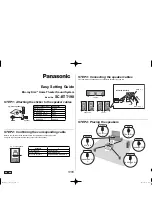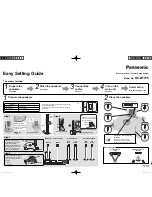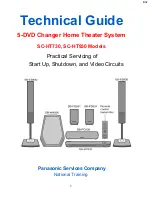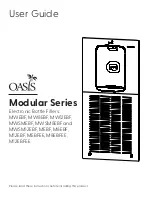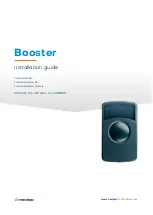
Page 8
Reference Manual
the system to be tuned to a flat response. More laborious, but at least as accurate, would be to
plot the responsecurve using a sweepable SWO. Both require a RPM .
The RTA and SWO methods involve muting all but one band on one side, firing pink noise or
the appropriate (X-over) frequency through the system at a comfortable level, and observing
the SPL at the RPM. Switch on an adjacent band. The measured SPL at the RPM should
increase by +3dB at thecrossover point. Repeat for all crossover points.
Double check by looking at the entire audio spectrum. In a hall, the frequency response of the
system will be colored (which is why massive systems are sometimes calibrated outdoors).
What you will be looking for is not a true flat response: that will only come after equalization.
Rather seek out fault lines between bands. If the frequency response is very curved indeed,
however, it might be better to use the crossover to flatten the room before applying EQ. In this
case, fault lines might just have to be accepted and compensated for as best you can with
system EQ.
Extremely stable high-guality potentiometers obviate the need for fixed card frequency
dividers offering a degree of on-site user control not found on certain more expensive units.
These operate in two switchable ranges, from 80 - 900 Hz, and from 800 Hz - 9 kHz. Turnover
frequencies beyond those limits are never normally required. The slope is 24 dB/octave. And
thefilters are the universally acclaimedlinkwitz-Riley type. High quality components (1% metal
film resistors and 2% capacitors) ensure zero phase and amplitude error at all crossover
frequencies.
For setting crossover frequencies between bins & horns etc., please refer to the
manufacturer's specifications. If possible, check response curves of the various loaded drivers
(i.e. in cabinets/behind horns) to avoid crossing over at a peak or trough. Look instead for
relatively flat matchingareas.
Never drive loudspeakers/horns at frequencies bellow the manufacturer's specified bandwidth.
TIP: Crossing over above a recommended frequency often puts less sfress on a horn driver or
tweeter, resultingin a longer diaphragm life andclarity, versus a slight drop in system efficiency.
Certain PA systems, particularly those required to deliver loud, deep bass, run the low end in
mono, while the highs are in stereo (low frequency sound is hard to localize ). By placing all
bass cabs in an array (the closer to a sphere the better, in practice two may be on top of two
others), efficiency is improved over all other stacking methods. E. g. two cabs together will
p3 dB more (double the volume) of low bass than the same two separated by a stage.
Four cabs together provide an extra +6 dB . Why? Together they form a single source. Apart
they are discrete sources. The spherical nature of bass waves means that apart there is bound
to be some phase cancellation in the middle. Try dropping two stones into a pond together and
apart in your mind's eye. Got the picture? In stereo mode the
can deliver mono bass
via the switchcalledMONOBASS.
Also, many studio nearfield monitors now come with optional mono sub-woofer systems. In
stereo mode the
can deliver a mono signal suitable for driving such a sub-woofer or
SPLAt RPM
Seeking Out Fault Lines
WCR 35
WCR 35
SETTING CROSSOVER FREQUENCIES
MONO-ING THE BASS
Содержание WCR - 35
Страница 1: ...WCR 35 User Manual...
Страница 3: ...Page 1 Reference Manual...
Страница 13: ...WCR 35 Manual de Usuario...
Страница 25: ...Equipson S A www equipson es support equipson es...



























